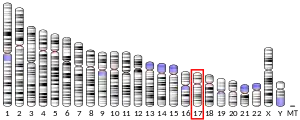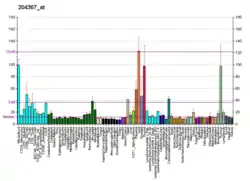Transcription factor Sp2 is a protein that in humans is encoded by the SP2 gene.[5][6][7]
Function
This gene encodes a member of the Sp subfamily of Sp/XKLF transcription factors. Sp family proteins are sequence-specific DNA-binding proteins characterized by an amino-terminal trans-activation domain and three carboxy-terminal zinc finger motifs. This protein contains the least conserved DNA-binding domain within the Sp subfamily of proteins, and its DNA sequence specificity differs from the other Sp proteins. It localizes primarily within subnuclear foci associated with the nuclear matrix, and can activate or in some cases repress expression from different promoters.[7]
Interactions
Sp2 transcription factor has been shown to interact with E2F1.[8]
References
- 1 2 3 GRCh38: Ensembl release 89: ENSG00000167182 - Ensembl, May 2017
- 1 2 3 GRCm38: Ensembl release 89: ENSMUSG00000018678 - Ensembl, May 2017
- ↑ "Human PubMed Reference:". National Center for Biotechnology Information, U.S. National Library of Medicine.
- ↑ "Mouse PubMed Reference:". National Center for Biotechnology Information, U.S. National Library of Medicine.
- ↑ Kingsley C, Winoto A (October 1992). "Cloning of GT box-binding proteins: a novel Sp1 multigene family regulating T-cell receptor gene expression". Mol Cell Biol. 12 (10): 4251–61. doi:10.1128/mcb.12.10.4251. PMC 360348. PMID 1341900.
- ↑ Scohy S, Van Vooren P, Szpirer C, Szpirer J (October 1998). "Assignment1 of Sp genes to rat chromosome bands 7q36 (Sp1), 10q31→q32.1 (Sp2), 3q24→q31 (Sp3) and 6q33 (Sp4) and of the SP2 gene to human chromosome bands 17q21.3→q22 by in situ hybridization". Cytogenet Cell Genet. 81 (3–4): 273–4. doi:10.1159/000015044. PMID 9730617. S2CID 46786094.
- 1 2 "Entrez Gene: SP2 Sp2 transcription factor".
- ↑ Rotheneder H, Geymayer S, Haidweger E (November 1999). "Transcription factors of the Sp1 family: interaction with E2F and regulation of the murine thymidine kinase promoter". J. Mol. Biol. 293 (5): 1005–15. doi:10.1006/jmbi.1999.3213. PMID 10547281.
Further reading
- Philipsen S, Suske G (1999). "A tale of three fingers: the family of mammalian Sp/XKLF transcription factors". Nucleic Acids Res. 27 (15): 2991–3000. doi:10.1093/nar/27.15.2991. PMC 148522. PMID 10454592.
- Nomura N, Nagase T, Miyajima N, Sazuka T, Tanaka A, Sato S, Seki N, Kawarabayasi Y, Ishikawa K, Tabata S (1995). "Prediction of the coding sequences of unidentified human genes. II. The coding sequences of 40 new genes (KIAA0041-KIAA0080) deduced by analysis of cDNA clones from human cell line KG-1". DNA Res. 1 (5): 223–9. doi:10.1093/dnares/1.5.223. PMID 7584044.
- Rotheneder H, Geymayer S, Haidweger E (2000). "Transcription factors of the Sp1 family: interaction with E2F and regulation of the murine thymidine kinase promoter". J. Mol. Biol. 293 (5): 1005–15. doi:10.1006/jmbi.1999.3213. PMID 10547281.
- Moorefield KS, Fry SJ, Horowitz JM (2004). "Sp2 DNA binding activity and trans-activation are negatively regulated in mammalian cells". J. Biol. Chem. 279 (14): 13911–24. doi:10.1074/jbc.M313589200. PMID 14726517.
- Phan D, Cheng CJ, Galfione M, Vakar-Lopez F, Tunstead J, Thompson NE, Burgess RR, Najjar SM, Yu-Lee LY, Lin SH (2004). "Identification of Sp2 as a transcriptional repressor of carcinoembryonic antigen-related cell adhesion molecule 1 in tumorigenesis". Cancer Res. 64 (9): 3072–8. doi:10.1158/0008-5472.CAN-03-3730. PMID 15126343.
- Phillips RJ, Tyson-Capper Née Pollard AJ, Bailey J, Robson SC, Europe-Finner GN (2005). "Regulation of expression of the chorionic gonadotropin/luteinizing hormone receptor gene in the human myometrium: involvement of specificity protein-1 (Sp1), Sp3, Sp4, Sp-like proteins, and histone deacetylases". J. Clin. Endocrinol. Metab. 90 (6): 3479–90. doi:10.1210/jc.2004-1962. PMID 15788387.
- Lee YC, Higashi Y, Luu C, Shimizu C, Strott CA (2005). "Sp1 elements in SULT2B1b promoter and 5'-untranslated region of mRNA: Sp1/Sp2 induction and augmentation by histone deacetylase inhibition". FEBS Lett. 579 (17): 3639–45. doi:10.1016/j.febslet.2005.05.041. PMID 15953604. S2CID 22203267.
- Simmons SO, Horowitz JM (2006). "Nkx3.1 binds and negatively regulates the transcriptional activity of Sp-family members in prostate-derived cells". Biochem. J. 393 (Pt 1): 397–409. doi:10.1042/BJ20051030. PMC 1383699. PMID 16201967.
- Moorefield KS, Yin H, Nichols TD, Cathcart C, Simmons SO, Horowitz JM (2006). "Sp2 localizes to subnuclear foci associated with the nuclear matrix". Mol. Biol. Cell. 17 (4): 1711–22. doi:10.1091/mbc.E05-11-1063. PMC 1415311. PMID 16467376.
- Das A, Fernandez-Zapico ME, Cao S, Yao J, Fiorucci S, Hebbel RP, Urrutia R, Shah VH (2007). "Disruption of an SP2/KLF6 repression complex by SHP is required for farnesoid X receptor-induced endothelial cell migration" (PDF). J. Biol. Chem. 281 (51): 39105–13. doi:10.1074/jbc.M607720200. PMID 17071613.
External links
- Sp2+Transcription+Factor at the U.S. National Library of Medicine Medical Subject Headings (MeSH)
- FactorBook SP2
This article is issued from Wikipedia. The text is licensed under Creative Commons - Attribution - Sharealike. Additional terms may apply for the media files.





